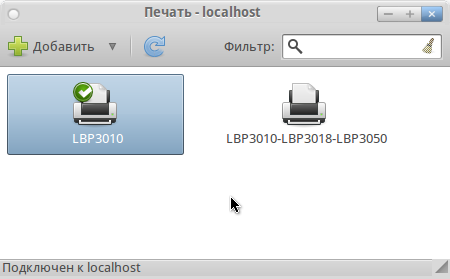Configuring a Canon LBP3010 Printer in Ubuntu 10.10

For almost a month and a half I tried to make this printer work (during this time I even managed to switch to the PinguyOS assembly, an overview of which may be coming soon). And I have not achieved any success in this, but only until today. A couple of days ago I began to look for fresh manuals for setting up this printer and comparing them, I managed to make my plan.
And now I want to share a working solution with the habrasoobschestvom. I hope this information is helpful.
Before performing all the instructions, it is better to keep the printer off.
So, the first point I propose to use the script for automatic configuration (which, however, did not work for me, but this is the simplest method to install the drivers themselves) printer, which can be downloaded here .
')
Next, unpack the archive and run the existing script (you should be in the terminal in the folder where the script of interest is canonLBP_install.sh) with the following command (in the terminal):
sudo ./canonLBP_install.sh LBP3010It is very convenient to install all the necessary drivers, as well as some additional packages from among the dependencies.
Next, go to System - Administration - Print and delete the printer that appears there, we will not need it anymore.
After that, run another command in the terminal:
sudo /usr/sbin/lpadmin -p LBP3010 -m CNCUPSLBP3050CAPTK.ppd -v ccp:/var/ccpd/fifo0This will create a new printer based on the pdd-file, in which, as I understand it, the principle of working with our LBP3010 (and, as the name implies, with LBP3050) is described. As a result of this action, a printer with the name LBP3010 will appear in System - Administration - Print.
Now we need to bind this printer to usb. To do this, run the following command in the terminal:
sudo /usr/sbin/ccpdadmin -p LBP3010 -o /dev/usb/lp0After that, the following should be written to the console:
CUPS_ConfigPath = /etc/cups/
LOG Path = None
UI Port = 59787
Entry Num : Spooler : Backend : FIFO path : Device Path : Status
----------------------------------------------------------------------------
[0] : LBP3010 : ccp : /var/ccpd/fifo0 : /dev/usb/lp0 : New!!All that remains to be done is to correct the ccpd script, which is an important link in the operation of the printer. Once again, we return to the terminal:
sudo gedit /etc/init.d/ccpdWith this command we open this script in the default text editor as root. Remove from this file everything that you see there and insert a new script:
# startup script for Canon Printer Daemon for CUPS (ccpd)
### BEGIN INIT INFO
# Provides: ccpd
# Required-Start: $local_fs $remote_fs $syslog $network $named
# Should-Start: $ALL
# Required-Stop: $syslog $remote_fs
# Default-Start: 2 3
# Default-Stop: 0 1 4 5 6
# Description: Start Canon Printer Daemon for CUPS
### END INIT INFO
DAEMON=/usr/sbin/ccpd
LOCKFILE=/var/lock/subsys/ccpd
PATH=/usr/local/sbin:/usr/local/bin:/sbin:/bin:/usr/sbin:/usr/bin
NAME=ccpd
DESC="Canon Printer Daemon for CUPS"
test -f $DAEMON || exit 0
. /lib/lsb/init-functions
case $1 in
start)
log_begin_msg "Starting $DESC: $NAME"
start-stop-daemon --start --quiet --exec $DAEMON
log_end_msg $?
;;
stop)
log_begin_msg "Stopping $DESC: $NAME"
start-stop-daemon --stop --quiet --oknodo --exec $DAEMON
log_end_msg $?
;;
status)
echo "$DESC: $NAME:" `pidof $NAME`
;;
restart)
log_begin_msg "Restarting $DESC: $NAME"
start-stop-daemon --stop --quiet --oknodo --exec $DAEMON
sleep 1
start-stop-daemon --start --quiet --exec $DAEMON
log_end_msg $?
;;
*)
echo "Usage: ccpd {start|stop|restart|status}"
exit 1
;;
esac
exit 0Then restart the printer service again from the terminal:
sudo /etc/init.d/ccpd restartIn response, you should see in the console:
* Restarting Canon Printer Daemon for CUPS: ccpd [ OK ]In order for the printer to work even after the system is restarted, execute one more command:
sudo update-rc.d ccpd defaults 50And you should get the following in response:
update-rc.d: warning: ccpd start runlevel arguments (2 3 4 5) do not match LSB Default-Start values (2 3)
update-rc.d: warning: ccpd stop runlevel arguments (0 1 6) do not match LSB Default-Stop values (0 1 4 5 6)
Adding system startup for /etc/init.d/ccpd ...
/etc/rc0.d/K50ccpd -> ../init.d/ccpd
/etc/rc1.d/K50ccpd -> ../init.d/ccpd
/etc/rc6.d/K50ccpd -> ../init.d/ccpd
/etc/rc2.d/S50ccpd -> ../init.d/ccpd
/etc/rc3.d/S50ccpd -> ../init.d/ccpd
/etc/rc4.d/S50ccpd -> ../init.d/ccpd
/etc/rc5.d/S50ccpd -> ../init.d/ccpdNow we can turn on the printer (I'm sure you were waiting for this moment;))
The system will have another printer called Canon LBP3010 / LBP3018 / LBP3050, which the system will set up as the default printer, which we absolutely do not need.
You need to tell the system to use the default printer that you and I created - that is, the LBP3010, and I personally left this new printer, just in case. If you delete and everything will work for you - please unsubscribe in the comments.
In the properties of this printer on the Policy tab, we tick off the reception of tasks, and sharing is allowed.
You can print a test page :)
The article was used materials:
help.ubuntu.com/community/CanonCaptDrv190
forum.ubuntu.ru/index.php?topic=94290.0
and a whole bunch of other things that turned out to be useful to one degree or another.
Source: https://habr.com/ru/post/107893/
All Articles